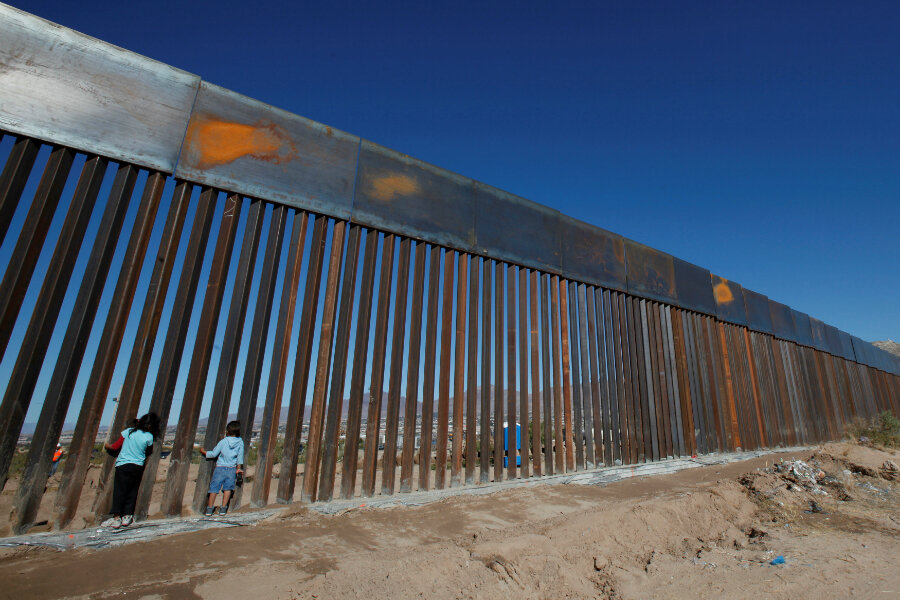Trump to sign executive order on building Mexican border wall
Loading...
President Donald Trump is taking concrete steps to fulfill his signature campaign promise: a physical wall (or fence) along the US southern border.
The executive order to kick off construction will form part of an immigration package that also includes a 30-day ban on refugees from certain Muslim-majority countries, a measure to defund so-called sanctuary cities, and a new policy to immediately jail anyone caught attempting to cross the border into the United States illegally, two administration officials told the AP.
Mr. Trump previewed the coming policy shifts with a tweet.
He is expected to sign the initial executive orders into law on Wednesday during a visit to the Department of Homeland Security, with further announcements to follow in the coming days.
Another memorable campaign promise – that Mexico will pay for the wall – requires more than just a stroke of a pen, but Mexico already faces an uncertain future regarding US trade relations. Facilitated by the 1994 North American Free Trade Agreement (NAFTA), 80 percent of Mexico’s exports end up in America’s sizable market. Trump’s threat of a 35-percent tariff on Mexican imports could prove disastrous for Mexico's economy. From Mexico's perspective, renegotiating the current trade agreement may represent the lesser of two evils.
One area for compromise, according to two Mexican government officials, may be regulations known as “rules of origin,” which often determine import taxes. As things stand now, Mexican-made vehicles can enter the US tax free, as long they contain at least 62.5 percent American parts, by value. Such rules help American companies and Mexican factories compete with car manufacturers overseas.
“What we want is to maintain free access for Mexican products, without restrictions, without tariffs and quotas,” Luis Videgaray Caso, Mexico's secretary of foreign affairs, told Reuters.
Tweaking these rules may result in conditions more favorable for American companies, which could satisfy Trump. Nevertheless, it remains to be seen how far NAFTA's leverage extends, with Mexico warning that it may withdraw from the deal if negotiations are unfavorable.
Funding issues aside, many wonder if the wall is feasible. Architects have said that construction of such a barrier would be “nearly impossible.” Fencing already covers over 650 miles of border, but logistics such as a 1970 agreement with Mexico prohibiting the blockage of rivers complicate plans to expand.
Furthermore, many are asking if a wall would accomplish its proposed goals of stopping immigration and protecting American jobs. Writing in The Conversation, David Cook Martín, a professor of sociology at Grinnell College warns that the wall is a simplistic solution to a host of complicated problems. To name one, half of undocumented migrants are people who have overstayed their visas, not ones who illegally crossed the border.
Additionally, the problems that accompany such a massive undertaking prevent the wall from being a silver-bullet solution. Requiring three times the concrete of the Hoover Dam, the costs would be astronomical. Dr. Martín estimated that current, more modest, barriers cost countries billions of dollars in federal support. He’s also found that they don’t necessarily stop immigration. Rather, they encourage more immigrants to cross at dangerous unwalled places, where construction would prove difficult, resulting in more deaths.
Globalization isn’t the only enemy to American companies. Despite losing 5 million factory jobs since 2005, US manufacturing is at an all-time high. The culprit? Domestic automation, not overseas workers, accounts for 88 percent of lost jobs.
Ultimately, Martín argues that physical barriers are something of an anachronism in our intricately connected world. As he writes: “[W]alling the world distracts citizens and policymakers from complex problems. Extreme economic inequality, global conflict and environmental decline surpass the borders and capacities of any single country.”
This report includes material from the Associated Press and Reuters.








